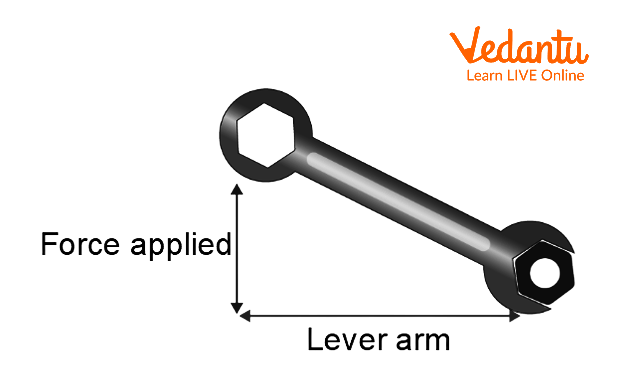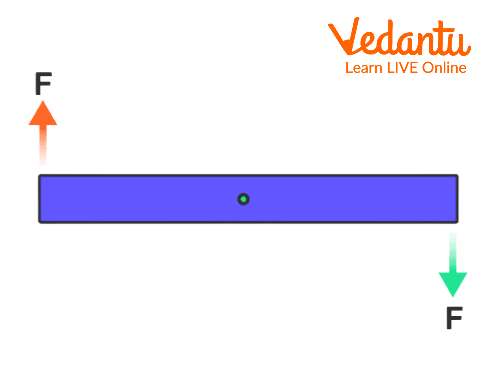




An Introduction to Torque in Physics
In Physics, torque is just the tendency of a force to turn or twist. Completely different terminologies like moment or moment of force are interchangeably used to describe torque. The distance of the point of application of force from the axis of rotation is typically known as the moment arm or lever arm.
This concept originated with the studies of Archimedes of usage of levers. In rotational mechanics, torque takes the place of force in linear kinematics. When you open a door, the torque applied within the situation permits it to move round the rotational axis.
What is Torque?
Torque is a measure of the force that may cause an object to rotate around an axis. As force is what causes an object to accelerate in linear kinematics, torque is what causes an object to acquire angular acceleration and it is a vector quantity. A force applied perpendicularly to a lever multiplied by its distance from the length of the lever arm is its torque.

Torque
Types of Torque
Torque can be both:
Static torque
Dynamic torque
Static Torque
A static torque is one which does not produce an angular acceleration. Someone pushing on a closed door is applying a static torque to the door because the door is not rotating approximately its hinges, despite the force applied. Someone pedalling a bicycle at constant speed is also applying a static torque because they're not accelerating.
Dynamic Torque
The drive shaft in a racing car accelerating from the start line is carrying a dynamic torque as it should be producing an angular acceleration of the wheels given that the car is accelerating along the track.
Equation of Torque
The magnitude of the torque vector for a torsion created by a given force (F) is :
$\tau = r \times F = r \,F \,sin\theta$
$\tau$ = torque
F = linear force
r = distance measured from the axis of rotation to where the application of linear force takes place
$\theta$= the angle among F and r
In this system, sinθ has no units, r has units of metres (m), and F happens to have units of Newtons (N). Combining these together, one can see that a unit of torque is a Newton-metre (Nm).
The SI unit for torque happens to be the newton-metre (N⋅m).
Now let’s find the formula or expression.
Rate of change of Angular Momentum when it comes to time = $\dfrac{\Delta L}{\Delta T}$
Now, $\dfrac{\Delta L}{\Delta T}=\dfrac{\Delta I\omega }{\Delta T}=I\cdot \dfrac{\Delta \omega }{\Delta T}$……. (1)
Here, I is certainly constant when the mass and shape of the item are unchanged.
Now $\dfrac{\Delta \omega }{\Delta T}$ refers to the rate of change of angular velocity with time i.e. angular acceleration ($\alpha$). So from equation four one can write,
$\dfrac{\Delta L}{\Delta T}=\alpha I$…………………(2)
I (moment of inertia) refers to the rotational equivalent of mass(inertia) of linear motion. Similarly, angular acceleration \alpha (alpha) certainly refers to the rotational motion equal to linear acceleration.
Torque ($\tau$) refers to the moment of force.
$\tau = r \times F = r \,F \,sin\theta$ ……………. (3)
Here, F is the force vector and r refers to the position vector and $\theta$ takes place to be the angle between the force vector and the lever arm vector. ‘x’ certainly denotes the cross product.
$\tau = r F sin \theta$
We know that according to Newton's Second law,
$F=ma$
$\Rightarrow \tau = r \,ma \,sin\theta$
$\Rightarrow \tau = r \,m \,\alpha \,r \,sin\theta$
$\Rightarrow \tau = m\,r^2\, \alpha \,sin \theta$
$\Rightarrow \tau= I\, \alpha \, sin\theta = \text{I}\times \alpha$ ………… (4)
$\theta$ is angular acceleration, I refer to the moment of inertia and X denotes cross product.
$\tau = I \alpha$.......(from equation 4)
$\tau = I \times \dfrac{(ω_2 – ω_1)}{t}$
here $\alpha$ = angular acceleration = time rate of change of the important angular velocity = $\dfrac{(ω_2 – ω_1)}{t}$
where $ω_2$ and $ω_1$ happen to be the final and initial angular velocities and t is the time gap or T
$\tau = I\,(ω_2 – ω_1)$ …………(5)
when, T = 0 (i.e., net torque is zero),
$I (\omega_2 - \omega_1)$ = 0
i.e., $I\omega_2=I \omega_1$…….. (6)
So from equation two and 4 one can get, $\dfrac{\Delta L}{\Delta T}=\tau$ , this certainly states that the rate of change of angular momentum with time is referred to as Torque.
A torque may be a twist of an item around a given axis, almost like how a linear force is a push or a pull. The product of the magnitude of the force and therefore the perpendicular distance of the line of action of a force from the axis of rotation is another definition of torque.
Measurement of Torque
The unit of torque is Newton and metre (N.m). The equation for torque is represented as the vector product of force and position vector. Using vector product notations, we will find the direction of torque.
$\tau = r \times F$

Measurement of Torque
Measuring a static torque during a non-rotating system is sometimes quite straightforward, and done by measuring a force. Measuring torque during a rotating system is significantly harder. One technique works by measuring strain within the metal of a drive shaft which is transmitting torque and causing this information wirelessly.
Examples of Torque
Some of the examples of torque are listed as follows:
Opening a bottle cap
Rotating the steering wheel of the car
Screwing the bolt and nut the usage of a wrench and nutcracker
Playing See-saw
Twisting the taps
Opening the doors
Solved Problems
1. A classroom door has a width of 80 cm. If the handle of the door is 30 cm from the edge and the Force of 8 N is applied on the handle, calculate the torque.
Ans. The distance of the handle of the door from edge = 30 cm.
Therefore, the line of action is 30/2 = 15 cm.
Measurement of the lever arm = d = 80 – 15 = 65 cm = 0.65 m
Force exerted = 8N
Torque = F × d= 8 × 6.5
Torque = 52 Nm.
Hence, the value of torque is 52 Nm.
2. The width of a door is 50 cm. If it is released with force of 2 N away from the hinges, calculate the torque produced which causes the door to open.
Ans: Force applied , F = 2 N
d is the length of the lever arm , that is 50 cm.
Measurement of lever arm in m = 0.50 m
Torque = F × d = 0.50 × 20
Torque = 10 Nm.
Hence, the value of torque is 52 Nm.
Conclusion
Just as a linear force is a push or a pull, a torque can be thought of as a twist to an object around a specific axis. It is also defined as the torque is the product of the magnitude of the force and the perpendicular distance of the line of action of a force from the axis of rotation. Given the length of the moment arm, the torque may be found directly. Measurement of torque and its applications are mentioned within the above article.
FAQs on Torque
1. What is torque in Physics and how is it mathematically represented?
Torque is the measure of the tendency of a force to rotate an object about an axis. It is mathematically represented as τ = r × F = r F sinθ, where τ is torque, F is the applied force, r is the distance (lever arm) from the axis of rotation, and θ is the angle between the force vector and the lever arm. The SI unit of torque is Newton-metre (N·m).
2. How are static and dynamic torque different? Give examples for each.
Static torque does not cause angular acceleration—it maintains rotational equilibrium. For example, pushing a closed door without causing it to move. Dynamic torque results in angular acceleration, as seen when a car's engine accelerates the wheels. The difference lies in whether or not there is a change in rotational speed.
3. Why is torque considered a vector quantity and what determines its direction?
Torque is a vector quantity because it has both magnitude and direction. Its direction is determined by the right-hand rule: if you curl your right-hand fingers in the direction of rotation, your thumb points along the torque vector (out of or into the plane). This ensures the rotational effect is fully described, not just its size.
4. What is the relationship between torque and angular acceleration as per CBSE 2025–26 syllabus?
The relationship is given by τ = Iα, where τ is the torque, I is the moment of inertia of the object, and α is the angular acceleration. This means a greater torque is needed to achieve the same angular acceleration for an object with a higher moment of inertia.
5. In what ways does torque differ from force? Why is this distinction important in Physics?
Force causes linear motion (translation), while torque causes rotational motion (twist). The distinction is crucial because problems involving rotation require analyzing torque instead of force to predict angular movement, such as opening doors or tightening bolts.
6. How can you measure torque in both static and rotating systems? What are common methods used?
In static systems, torque is measured by applying a force at a known distance from the pivot and calculating τ = F × r. In rotating systems, torque measurement often uses strain gauges attached to shafts or by measuring the angular acceleration if the moment of inertia is known.
7. What does the concept of rotational equilibrium mean and how is it applied in practical scenarios?
Rotational equilibrium occurs when the net torque on an object is zero, so it does not experience angular acceleration. Practically, this principle ensures objects like seesaws, levers, and bridges remain stable by balancing all torques acting on them.
8. Why is the perpendicular distance important in the calculation of torque?
Torque is maximized when the force acts perpendicular to the lever arm. The component of force along the arm does not cause rotation; only the perpendicular component does, making the calculation τ = r F sinθ essential for accuracy.
9. List at least three real-life applications of torque based on the syllabus for Physics 2025–26.
- Opening and closing doors (hinge acts as the axis)
- Using a wrench to tighten or loosen bolts
- Rotating a steering wheel in vehicles to change direction
- Operating seesaws, swings, or bottle openers
10. What are common misconceptions students might have about torque, and how can these be addressed?
- Confusing torque with force—remember, torque causes rotation while force causes translation.
- Ignoring the angle—using the simple product F × r without considering the sinθ factor can lead to errors.
- Misjudging units—torque is measured in Newton-metre, not just Newtons.
Clarifying these points during practice with examples and conceptual questions helps in avoiding mistakes in exams.
























